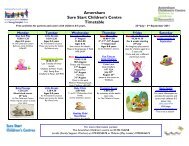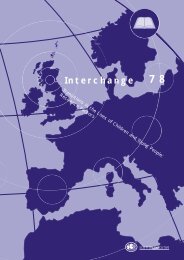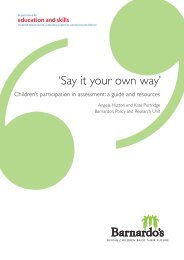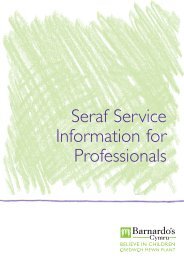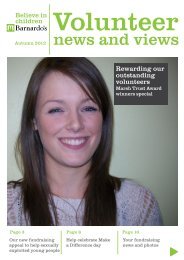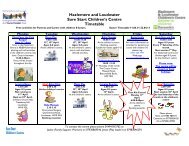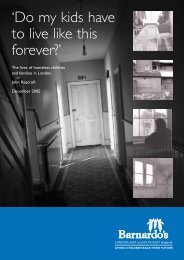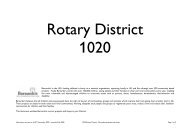Download the full report for free (PDF)
Download the full report for free (PDF)
Download the full report for free (PDF)
Create successful ePaper yourself
Turn your PDF publications into a flip-book with our unique Google optimized e-Paper software.
Sure Start<br />
Hartcliffe, Highridge and<br />
Withywood<br />
Evaluation of <strong>the</strong> Family Link<br />
Worker Service<br />
Karen McInnes and Emma Burton<br />
Policy and Research Unit
Introduction<br />
Policy and Research Unit<br />
The Family Link Worker service is a non-statutory home visiting scheme, which works with<br />
families to:<br />
• enhance <strong>the</strong> development of pre-school children;<br />
• enable parents and carers to feel more confident about <strong>the</strong>mselves;<br />
• reduce isolation <strong>for</strong> families;<br />
• in<strong>for</strong>m families about services and activities in <strong>the</strong> area and<br />
• encourage and empower individuals to look at new opportunities <strong>for</strong> <strong>the</strong>mselves and <strong>the</strong>ir<br />
families.<br />
The service was started in September 2001 with a brief to give precedence to families with<br />
parents under 25, families having <strong>the</strong>ir first child and vulnerable families. The Family Link<br />
Workers’ (FLWs) primary aim is to work alongside parents to empower <strong>the</strong>m to make choices<br />
about accessing services and to consider changes <strong>the</strong>y wish to make <strong>for</strong> <strong>the</strong>mselves and <strong>the</strong>ir<br />
family.<br />
The main emphasis of <strong>the</strong>ir work has been on getting families to groups in order <strong>for</strong> families to<br />
establish sustainable networks within <strong>the</strong>ir community and to build <strong>the</strong>ir self-esteem through<br />
participating in groups, activities and going on courses. They also work alongside parents at home<br />
on issues such as day-to-day routines, behaviour management, health and safety issues, budgeting<br />
and healthy eating.<br />
This particular service was chosen as <strong>the</strong> initial pilot <strong>for</strong> <strong>the</strong> evaluation as it was a discrete and<br />
unique service acknowledged by o<strong>the</strong>r outside agencies to provide a successful service. It is<br />
managed by an enthusiastic co-ordinator who was willing to give time and energy to <strong>the</strong> project.<br />
It provided an opportunity <strong>for</strong> <strong>the</strong> evaluation team to test <strong>the</strong> robustness of <strong>the</strong> data held on <strong>the</strong><br />
data monitoring system and would feed into <strong>the</strong> review and evaluation process <strong>for</strong> all services as<br />
an example of what could be achieved. It also provided an opportunity <strong>for</strong> <strong>the</strong> newly <strong>for</strong>med<br />
evaluation team to work toge<strong>the</strong>r and provided me with a chance to understand <strong>the</strong> intricacies of<br />
<strong>the</strong> Sure Start project at Hartcliffe, Highridge and Withywood.<br />
Evaluation of <strong>the</strong> Family Link Worker service occurred from April to June 2004 and employed two<br />
main data collection methods: analysis of closed files and a semi-structured group interview with<br />
<strong>the</strong> FLW team. This <strong>report</strong> will now detail <strong>the</strong> methods used and present <strong>the</strong> findings with a<br />
summary and recommendations.<br />
PAGE 2 of 26
Methodology<br />
Analysis of closed cases<br />
Policy and Research Unit<br />
The data monitoring system provided details of 156 closed cases seen by <strong>the</strong> Family Link Worker<br />
service up to <strong>the</strong> end of May 2004. Details included Sure Start number, date first seen by <strong>the</strong><br />
service and o<strong>the</strong>r Sure Start groups and services used by <strong>the</strong> family. This data provided a starting<br />
point <strong>for</strong> collection of in<strong>for</strong>mation and enabled verification of <strong>the</strong> in<strong>for</strong>mation once actual files<br />
were scrutinised. A sample of 75 closed cases were <strong>the</strong>n analysed in detail using a template<br />
devised by <strong>the</strong> evaluation team (see appendix a). This included in<strong>for</strong>mation such as date case<br />
referred, reason <strong>for</strong> referral, o<strong>the</strong>r groups and agencies linked with, date of closure and reason <strong>for</strong><br />
closure. This in<strong>for</strong>mation was <strong>the</strong>n compared with <strong>the</strong> original data monitoring in<strong>for</strong>mation and<br />
analysed in depth <strong>for</strong> relationships and patterns between <strong>the</strong> in<strong>for</strong>mation. A subsequent analysis<br />
of <strong>the</strong> files also identified length of time between referral and first visit and <strong>the</strong> FLW <strong>for</strong> <strong>the</strong><br />
family. Analysis was primarily quantitative in nature with some limited qualitative analysis. More<br />
in-depth qualitative analysis detailing practical advice given to families was not possible due to <strong>the</strong><br />
limited time scale of <strong>the</strong> project.<br />
Semi-structured group interview<br />
An hour-long semi-structured group interview was conducted with <strong>the</strong> FLW team. Six team<br />
members were present as well as <strong>the</strong> co-ordinator and a social worker linked with <strong>the</strong> project.<br />
The interview was not transcribed due to technical problems but comprehensive notes were<br />
taken. For a copy of <strong>the</strong> interview schedule see appendix b.<br />
Findings<br />
Overview of closed cases<br />
Success was measured using terminology taken from <strong>the</strong> files and agreed with <strong>the</strong> FLWs during<br />
<strong>the</strong> group interview. The terminology used to describe success was ‘empowerment of families’<br />
and this included going to groups, all needs being met and <strong>the</strong> family moving on and making<br />
decisions <strong>for</strong> <strong>the</strong>mselves.<br />
Using this success criterion, analysis of <strong>the</strong> number of appropriate referrals made to <strong>the</strong> service<br />
indicates a success rate of 68%. As will be explained later in <strong>the</strong> <strong>report</strong>, <strong>the</strong>re were many reasons<br />
<strong>for</strong> closure, (service not required, unable to contact and not meet criteria n=53) which implied<br />
inappropriate referral to <strong>the</strong> service and when <strong>the</strong>se are removed from <strong>the</strong> total number of cases<br />
<strong>the</strong> success rate is high. When <strong>the</strong>se cases are included in <strong>the</strong> final analysis <strong>the</strong> success rate is<br />
20%. There is no indication of partial success o<strong>the</strong>r <strong>the</strong>n through anecdotal evidence.<br />
There was a distinct pattern to <strong>the</strong> successful cases. In <strong>the</strong> majority of cases <strong>the</strong> family had been<br />
referred in order to access groups or because <strong>the</strong> family was isolated. In all but one case <strong>the</strong><br />
family was seen <strong>for</strong> one year or less and in all but one case <strong>the</strong> family had been linked to a discrete<br />
number of groups (average 4 groups).<br />
PAGE 3 of 26
General analysis of closed cases<br />
Referrers<br />
Policy and Research Unit<br />
The main referring agency was health visitors (60%) of all referrals being made from <strong>the</strong>m. A<br />
variety of o<strong>the</strong>r agencies also refer: from social services, education and health. The referrals<br />
collated under ‘o<strong>the</strong>r’ were a guardian, Teenage Parents, a GP and an inclusion worker.<br />
Reasons <strong>for</strong> referral<br />
PAGE 4 of 26
Policy and Research Unit<br />
The main reason <strong>for</strong> referral was <strong>for</strong> families to access groups (40%). This was followed by<br />
parents feeling isolated/depressed which links to families needing to access groups. ‘Families being<br />
new to <strong>the</strong> area’ was also a popular reason <strong>for</strong> families to be referred and this links with one of<br />
<strong>the</strong> original target referral criterion <strong>for</strong> <strong>the</strong> service. There were 4 cases where <strong>the</strong> reason <strong>for</strong><br />
referral was ei<strong>the</strong>r not stated or <strong>the</strong> reasons were not in-keeping with <strong>the</strong> remit <strong>for</strong> <strong>the</strong> service.<br />
Referrals to <strong>the</strong> service included many complex cases with child protection issues, which involved<br />
<strong>the</strong> FLWs being involved in case conferences.<br />
Length of time case open<br />
The length of time cases were open ranged from not seen to 28 months, with an average of 6<br />
months. The reasons <strong>for</strong> referral and closure were scattered across <strong>the</strong> length of time <strong>the</strong> cases<br />
were open. The only patterns to note were that cases where <strong>the</strong> service were unable to contact<br />
<strong>the</strong> family tended to be clustered around <strong>the</strong> shorter lengths of time <strong>the</strong> cases were open and that<br />
<strong>the</strong> cases where <strong>the</strong> family were not moving on were clustered around <strong>the</strong> families being on <strong>the</strong><br />
caseload <strong>for</strong> longer periods of time (see Appendix c)<br />
PAGE 5 of 26
Length of time from referral to first visit<br />
Policy and Research Unit<br />
The majority of cases were seen within one month with only a few cases taking longer than two<br />
months to be seen from referral.<br />
Groups and services<br />
PAGE 6 of 26
Policy and Research Unit<br />
Out of <strong>the</strong> 75 cases 39 families were linked to groups and/or services with 36 families having no<br />
links. Across <strong>the</strong> 39 families <strong>the</strong>re were 172 separate referrals with 109 being to Sure Start<br />
services and 62 to o<strong>the</strong>r services. When compared to <strong>the</strong> original data monitoring system<br />
in<strong>for</strong>mation only <strong>the</strong> Sure Start services were noted which reflects <strong>the</strong> fact that <strong>the</strong> service were<br />
engaging in more work than could be evidenced through <strong>the</strong> data collection system.<br />
Reasons <strong>for</strong> closure<br />
The main reasons <strong>for</strong> closure were because <strong>the</strong> family did not require <strong>the</strong> service, <strong>the</strong> FLWs were<br />
unable to contact <strong>the</strong> family or <strong>the</strong> family moved out of <strong>the</strong> area. There was a clear cross-section<br />
of families that <strong>the</strong> FLWs were unable to contact with no one group being dominant. Two cases<br />
PAGE 7 of 26
Policy and Research Unit<br />
did not even meet <strong>the</strong> referral criteria with one family referred with a child over five years of age<br />
and ano<strong>the</strong>r family referred with no child! Cases being closed <strong>for</strong> <strong>the</strong>se reasons would indicate an<br />
issue concerned with referral and if <strong>the</strong>se cases are removed from <strong>the</strong> total number of cases <strong>the</strong><br />
percentage of successful cases is 68%.<br />
In-depth analysis of successful cases<br />
Successful Families<br />
Reason <strong>for</strong><br />
Referral<br />
Referrer Length of time<br />
seen<br />
Isolated/depressed HV 14 months 5<br />
Access to groups SW 10 months 6<br />
Help with child Self 2 months 2<br />
Isolated/depressed HV 10 months 2<br />
Access to groups HV 5 months 5<br />
Help with child SBAS 7 months 1<br />
New to area HV 13 months 5<br />
Access groups HV 13 months 6<br />
Isolated/depressed HV 28 months 14<br />
Access groups FLW 3 months 3<br />
Access groups Self 4 months 5<br />
New to area Self 2 months 2<br />
Access groups Self 6 months 6<br />
Mo<strong>the</strong>r returning to<br />
family<br />
Guardian 7 months 5<br />
Isolated/depressed Self 9 months 3<br />
Partial Success<br />
No of groups<br />
linked with<br />
This was not analysed in-depth although anecdotal evidence gives some idea of <strong>the</strong> complexity of<br />
<strong>the</strong> work with which <strong>the</strong> FLWs engage and an idea of how success may be determined in more<br />
limited ways. Examples include FLWs:<br />
• taking families to buy second –hand clothing <strong>for</strong> children;<br />
• helping families apply <strong>for</strong> grants to buy household resources;<br />
• helping families apply <strong>for</strong> loans;<br />
• giving families advice on how to budget on a week-by-week basis;<br />
PAGE 8 of 26
• taking families shopping <strong>for</strong> Christmas presents;<br />
• showing parents how to play with <strong>the</strong>ir children;<br />
• giving parents advice on health and safety issues.<br />
Success by referring agency<br />
Referring agency Number %<br />
Teacher 0/1 0<br />
South Bristol Advice Service 1/4 25<br />
Health Visitor 6/45 15<br />
Social Worker 1/9 11<br />
Self 5/6 83<br />
Midwife 0/4 0<br />
FLW 1/2 50<br />
O<strong>the</strong>r 1/4 25<br />
Policy and Research Unit<br />
The most successful referring agency was <strong>the</strong> “self-referrals”. 5 out of 6 (83%) self-referrals were<br />
successful and case notes indicate that <strong>the</strong> self-referrals were as complex as agency referrals. This<br />
high success rate is probably a reflection of <strong>the</strong> initial motivation of <strong>the</strong> family to improve <strong>the</strong>ir<br />
situation and would bode well <strong>for</strong> <strong>the</strong> service to work positively with <strong>the</strong>m. O<strong>the</strong>r agencies had<br />
varying degrees of success but none of <strong>the</strong> midwife referrals were successful.<br />
Success by reason <strong>for</strong> referral<br />
Reason <strong>for</strong> referral Number %<br />
New to area 2/14 15<br />
Isolated/depressed 4/18 23<br />
Access to groups 6/30 20<br />
Help with children 2/8 25<br />
Mo<strong>the</strong>r returning to family 1/1 100<br />
No reason 0/2 0<br />
Death of a family member 0/1 0<br />
Agoraphobic 0/1 0<br />
The successful reasons <strong>for</strong> referral were <strong>the</strong> ones that fitted <strong>the</strong> remit of <strong>the</strong> FLW service except<br />
<strong>the</strong> reason of being ’new to <strong>the</strong> area’ which could indicate a need <strong>for</strong> a change in referral criteria.<br />
It would suggest that families who are new to <strong>the</strong> area are immediately put into contact with <strong>the</strong><br />
PAGE 9 of 26
Policy and Research Unit<br />
FLW service with no exploration of whe<strong>the</strong>r <strong>the</strong>y actually need <strong>the</strong> service or want it. It is<br />
interesting to note that <strong>the</strong> four cases where <strong>the</strong>re was ei<strong>the</strong>r no reason or a reason not within<br />
<strong>the</strong> FLW remit were all unsuccessful which again highlights <strong>the</strong> need <strong>for</strong> more robust referral<br />
criteria.<br />
Referring agency and reason <strong>for</strong> referral<br />
All referring agencies were using a range of reasons <strong>for</strong> referring <strong>the</strong> families to <strong>the</strong> service and<br />
<strong>the</strong>re was no evident pattern in <strong>the</strong> data between <strong>the</strong>se two variables. It is possible that <strong>the</strong> high<br />
number of unsuccessful cases is due to a lack of clarity about <strong>the</strong> referral criteria itself and<br />
referring agencies not ascertaining <strong>the</strong> precise needs of <strong>the</strong> family or <strong>full</strong>y explaining <strong>the</strong> FLW<br />
service prior to referring.<br />
Success and length of time seen<br />
Length of Success<br />
time seen<br />
20 0/2<br />
21 0<br />
22 0/1<br />
23 0/1<br />
24 0<br />
25 0<br />
26 0<br />
27 0<br />
28 1/1<br />
not seen 0/6<br />
Policy and Research Unit<br />
The data would suggest that <strong>the</strong> most success is gained when cases are open <strong>for</strong> over 2 months up<br />
to a year. Apart from <strong>the</strong> unusual case of 28 months all <strong>the</strong> longer cases in our sample were<br />
unsuccessful. The cases that were not seen or were seen <strong>for</strong> 2 months or less were closed <strong>for</strong><br />
reasons mainly due to ei<strong>the</strong>r <strong>the</strong> FLWs being unable to contact <strong>the</strong> family, <strong>the</strong> service not being<br />
required or <strong>the</strong> family moving out of <strong>the</strong> area. This would again indicate that referring agencies<br />
were not ascertaining <strong>the</strong> needs of <strong>the</strong> family or not explaining <strong>the</strong> nature of <strong>the</strong> service <strong>the</strong> FLWs<br />
could provide and <strong>the</strong>re<strong>for</strong>e inappropriate referrals were being made.<br />
Success and length of time from referral to first visit<br />
The highest rate of success was in cases where <strong>the</strong> time between referral and first visit was a<br />
month or less (23%). In cases where <strong>the</strong> referral rate was 2 or more months <strong>the</strong> success rate fell<br />
to 8%. This would indicate <strong>the</strong> need <strong>for</strong> cases to be seen as quickly as possible and would also<br />
suggest that having a waiting list is inappropriate. With robust referral criteria all families should<br />
be seen within one month. When <strong>the</strong> service is at <strong>full</strong> capacity referrers should be notified to<br />
make no more referrals until <strong>the</strong> service is able to process <strong>the</strong>m. There should also be a maximum<br />
length of time that <strong>the</strong> service attempt to contact a family, <strong>for</strong> example 3 months, <strong>the</strong>n if <strong>the</strong>re is<br />
no contact closure should occur.<br />
Success and linking to groups and/or services<br />
Out of <strong>the</strong> 75 closed cases analysed 39 families were linked to groups and/or services and 36<br />
families were not. All 15 of <strong>the</strong> successful cases occurred with families that were linked to groups<br />
and highlights <strong>the</strong> crucial nature of <strong>the</strong> service in linking families to groups and/or services and <strong>the</strong><br />
impact this has on a successful outcome.<br />
Success and Family Link Worker<br />
A coding system was used in order that <strong>the</strong> family link worker dealing with each case could be<br />
identified and <strong>the</strong>ir success rate determined. Overall all family link workers experienced success<br />
and failure with <strong>the</strong>ir cases and no pattern was evident. This would indicate that <strong>the</strong> co-ordinator<br />
PAGE 11 of 26
Policy and Research Unit<br />
is making a good match between <strong>the</strong> FLW and <strong>the</strong> family in terms of <strong>the</strong> approach and skills that<br />
each FLW can offer. From <strong>the</strong> group interview it was also evident that <strong>the</strong> FLWs had very<br />
positive attitudes to <strong>the</strong>ir job and <strong>the</strong> families <strong>the</strong>y worked with and this underpinned <strong>the</strong>ir<br />
successful work.<br />
Family Link Worker and length of case<br />
The data was analysed to see if <strong>the</strong>re was a pattern between <strong>the</strong> family link worker and <strong>the</strong> length<br />
of time <strong>the</strong> case was open. Again, no pattern was evident.<br />
Analysis of group interview<br />
The group interview lasted an hour and was a very positive experience. There was a high level of<br />
agreement amongst <strong>the</strong> members of staff about <strong>the</strong>ir role and how <strong>the</strong>y worked and <strong>the</strong>y<br />
appeared to be a highly supportive team of each o<strong>the</strong>r. They recognised <strong>the</strong> stressful nature of<br />
<strong>the</strong>ir job and <strong>the</strong> families <strong>the</strong>y worked with but <strong>the</strong>y were all extremely positive and enjoyed <strong>the</strong>ir<br />
job.<br />
Role of <strong>the</strong> Family Link Worker<br />
There was agreement that <strong>the</strong> role of <strong>the</strong> family link worker has changed since <strong>the</strong> service began<br />
with more emphasis on linking families with groups and/or services and with actually facilitating<br />
groups. It would seem that linking families to groups enable <strong>the</strong> FLWs to achieve successful<br />
outcomes and all <strong>the</strong> successful cases were with families that had been linked to groups and/or<br />
services and so this would appear to be an area where <strong>the</strong> service should focus. This is fur<strong>the</strong>r<br />
emphasised by <strong>the</strong> fact that <strong>the</strong>y all saw <strong>the</strong>ir main role as linking families to groups and/or<br />
services and this was <strong>the</strong> primary way of empowering people.<br />
Their role also encompasses working with parents and giving <strong>the</strong>m advice on many different issues<br />
<strong>for</strong> example:<br />
• money management;<br />
• household management;<br />
• parenting skills – advice on sleeping, feeding and playing.<br />
This would seem to be an aspect of <strong>the</strong>ir role that <strong>the</strong>y make fleeting reference to which is<br />
actually an important part of <strong>the</strong>ir job.<br />
They felt <strong>the</strong>re was a lot of misunderstanding amongst o<strong>the</strong>r professionals about <strong>the</strong>ir role and<br />
considering <strong>the</strong> high number of inappropriate referrals to <strong>the</strong> service this would seem to be <strong>the</strong><br />
case.<br />
Their role with children<br />
They all agreed that <strong>the</strong>y worked with children in two main ways. The first was to act as a<br />
referring agency on behalf of <strong>the</strong> child referring to o<strong>the</strong>r agencies depending on <strong>the</strong> needs of <strong>the</strong><br />
child. The second way was to play with <strong>the</strong> child in front of <strong>the</strong> parent(s) and <strong>the</strong>reby model<br />
PAGE 12 of 26
Policy and Research Unit<br />
appropriate interactions, which would foster <strong>the</strong> child’s development. They also recognised that<br />
by linking families to groups where <strong>the</strong> child would ei<strong>the</strong>r take part or be looked after <strong>the</strong>y were<br />
fostering <strong>the</strong> child’s socialisation.<br />
Referring agencies<br />
They stated that a whole range of agencies referred to <strong>the</strong>m but <strong>the</strong> main agency was <strong>the</strong> health<br />
visitors this was confirmed by analysis of <strong>the</strong> closed files. They stated that in <strong>the</strong> beginning <strong>the</strong>y<br />
had a lot of self-referrals but <strong>the</strong>se had now tailed off. They did not know why. Considering <strong>the</strong><br />
success rate of self-referrals <strong>the</strong>y need to analyse this trend more closely. They also stated that<br />
<strong>the</strong> reasons <strong>for</strong> referral are not always clear and analysis of <strong>the</strong> closed files confirms this.<br />
Groups and services<br />
They recognised that <strong>the</strong>y linked with a wide range of groups and services and <strong>the</strong>y also enjoyed<br />
<strong>the</strong> relatively new role of facilitating groups. They had a number of ideas <strong>for</strong> new groups <strong>the</strong>y<br />
would like to set up based on <strong>the</strong> needs of <strong>the</strong> families. These included: sports groups, a group <strong>for</strong><br />
victims of domestic abuse, parenting groups and groups <strong>for</strong> mo<strong>the</strong>r and fa<strong>the</strong>rs.<br />
Support and supervision<br />
The staff were very positive about <strong>the</strong> support and supervision <strong>the</strong>y received. They recognised<br />
that <strong>the</strong>y received both <strong>for</strong>mal and in<strong>for</strong>mal support from <strong>the</strong>ir co-ordinator and from each o<strong>the</strong>r<br />
and that this was invaluable. There was also recognition of <strong>the</strong> health and safety issues concerning<br />
<strong>the</strong>ir role and all FLWs are issued with mobile phones. They have also had <strong>the</strong> opportunity to<br />
observe one ano<strong>the</strong>r, learn from each o<strong>the</strong>r and build up <strong>the</strong>ir own skills.<br />
Closure of cases<br />
This seemed an area of difficulty <strong>for</strong> <strong>the</strong> service. They stated that cases were closed <strong>for</strong> a variety<br />
of reasons: non-engagement by <strong>the</strong> family, successful families, child protection issues (where it<br />
would be inappropriate <strong>for</strong> <strong>the</strong> service to remain in contact), referral to ano<strong>the</strong>r agency, <strong>the</strong> family<br />
moving out of area and <strong>the</strong> child becoming too old <strong>for</strong> <strong>the</strong> service. Many of <strong>the</strong> staff stated that<br />
<strong>the</strong>y found it difficult to close cases and needed help with this. It is interesting to note that all bar<br />
one of <strong>the</strong> cases in this sample that were open <strong>for</strong> a long time were unsuccessful and <strong>the</strong>re<strong>for</strong>e<br />
this is an area on which <strong>the</strong> service needs to focus.<br />
Development of <strong>the</strong> service<br />
The FLWs had many ideas <strong>for</strong> how <strong>the</strong> service could develop. These included:<br />
• working with older children possibly up to eleven years of age;<br />
• working on a parenting education package and <strong>the</strong>re is work being done on this;<br />
• participating in assertiveness training and <strong>the</strong>re was acknowledgement that some members<br />
of staff had received this in <strong>the</strong> beginning and<br />
• issues concerned with <strong>the</strong> strategic development of <strong>the</strong> service in <strong>the</strong> light of <strong>the</strong><br />
Children’s Centre and Children’s Trust.<br />
PAGE 13 of 26
Recommendations<br />
Policy and Research Unit<br />
From <strong>the</strong> analysis of <strong>the</strong> closed files and <strong>the</strong> group interview <strong>the</strong> following recommendations can<br />
be made:<br />
• To reassess <strong>the</strong> referral criteria to ensure that appropriate families are referred to <strong>the</strong><br />
service.<br />
• To consider removing ‘new to <strong>the</strong> area’ as a referral criterion.<br />
• To consider re-marketing <strong>the</strong> service so that all referring agencies are clear about <strong>the</strong><br />
remit of <strong>the</strong> service and make appropriate referrals.<br />
• To ensure that all referrers make <strong>full</strong> and detailed referrals giving clear indication of <strong>the</strong><br />
families needs and circumstances.<br />
• To have an initial telephone discussion with <strong>the</strong> referring agency be<strong>for</strong>e visiting.<br />
• To remove <strong>the</strong> waiting list, recognise when <strong>the</strong> service is at <strong>full</strong> capacity and notify<br />
referrers accordingly.<br />
• To consider how to best target and market <strong>the</strong> service to increase <strong>the</strong> number of selfreferrals.<br />
• To develop a transparent and rigorous system to review and evaluate all files.<br />
• To ensure that all referrals are seen within one month.<br />
• To develop a rapid and fair system <strong>for</strong> cases where <strong>the</strong> service is unable to make contact.<br />
• To undertake fur<strong>the</strong>r evaluation of <strong>the</strong> service – <strong>for</strong> example analyse open cases and a user<br />
satisfaction survey (see Appendix d <strong>for</strong> letter and questionnaire).<br />
• To explore with service users <strong>the</strong>ir reasons <strong>for</strong> being involved with <strong>the</strong> service, record this<br />
and evaluate it at closure (Use initial questions from <strong>the</strong> questionnaire <strong>for</strong> this).<br />
• To amend <strong>the</strong> data collection system to monitor links with o<strong>the</strong>r agencies.<br />
• To fur<strong>the</strong>r develop <strong>the</strong> service using ideas generated by <strong>the</strong> family link worker staff.<br />
PAGE 14 of 26
Appendix a Template<br />
Identification number:<br />
Referred by: Date:<br />
Reason(s) <strong>for</strong> Referral:<br />
Go to Groups * Isolation *<br />
Money Management * Depression *<br />
Parenting skills * New to Area *<br />
Family Priorities (please tick all that apply)<br />
Go to Groups * Isolation *<br />
Money Management * Depression *<br />
Parenting skills * New to Area *<br />
Sleep patterns * Play *<br />
Housing * Health Problems/Disability *<br />
O<strong>the</strong>r _________________ (please state)<br />
Designated Health Visitor:<br />
Designated Social Worker:<br />
Non Sure Start Agencies family has been introduced to:<br />
Sure Start Groups attended because of FL intervention:<br />
Closure date:<br />
Reason <strong>for</strong> Closure:<br />
Policy and Research Unit<br />
Dates:<br />
Dates<br />
Unable to Contact * Not moving in Situation *<br />
Empowered/All needs met * Moved out of Area *<br />
PAGE 15 of 26
Child Over 4 *<br />
O<strong>the</strong>r ______________________ (please state)<br />
Policy and Research Unit<br />
Successful (please tick)/Unsuccessful (please cross) Outcomes (please refer to <strong>the</strong><br />
original family priorities):<br />
Go to Groups * Isolation *<br />
Money Management * Depression *<br />
Parenting skills * New to Area *<br />
Sleep patterns * Play *<br />
Housing * Health Problems/Disability *<br />
O<strong>the</strong>r successful work carried out:<br />
___________________________________________________________<br />
___________________________________________________ (please state)<br />
PAGE 16 of 26
Appendix b<br />
Questions <strong>for</strong> group discussion with Family Link Workers<br />
Role<br />
How do you see your role as a family link worker?<br />
How do you help families/parents?<br />
How do you help children?<br />
Referrals<br />
Who refers cases to you?<br />
Are <strong>the</strong> reasons <strong>for</strong> referral always clear?<br />
Links<br />
Which groups or services do you link with?<br />
Why do you link with those particular groups?<br />
Policy and Research Unit<br />
Are <strong>the</strong>re any groups or services that you would like to link with but currently don’t?<br />
Do you think your role is understood by those you link with?<br />
Supervision<br />
What support or supervision do you receive whilst working with a family?<br />
What do you feel about this support?<br />
Closure<br />
What are <strong>the</strong> reasons <strong>for</strong> closing a case?<br />
Are <strong>the</strong>re any difficulties in closing cases?<br />
Success<br />
How do you measure success with a family?<br />
How do you see your work contributing to <strong>the</strong> four Sure Start objectives?<br />
The future<br />
PAGE 17 of 26
How would you like to see <strong>the</strong> family link worker service develop?<br />
Policy and Research Unit<br />
PAGE 18 of 26
Appendix c Analysis by length of time seen<br />
Length of time seen Reason <strong>for</strong> referral Reason <strong>for</strong> closure<br />
New to area<br />
Isolated/depressed<br />
Access groups<br />
New to area<br />
Help with child<br />
Access groups<br />
3 months Isolated/depressed<br />
Isolated/depressed<br />
New to area<br />
Access groups<br />
Isolated/depressed<br />
4 months Access groups<br />
Access groups<br />
Death of family member<br />
Access groups<br />
5 months Access groups<br />
Access groups<br />
Isolated/depressed<br />
Isolated/depressed<br />
Access groups<br />
6 months Access groups<br />
Access groups<br />
Access groups<br />
7 months Access groups<br />
Help with child<br />
Mo<strong>the</strong>r returning to family<br />
Policy and Research Unit<br />
Empowered/needs met<br />
Not require service<br />
Unable to contact<br />
Unable to contact<br />
Unable to contact<br />
Unable to contact<br />
Unable to contact<br />
Moved out of area<br />
Not require service<br />
Empowered/needs met<br />
Moved out of area<br />
Unable to contact<br />
Empowered/needs met<br />
Not moving in situation<br />
Not require service<br />
Empowered/needs met<br />
Not require service<br />
Unable to contact<br />
Unable to contact<br />
Not require service<br />
Unable to contact<br />
Unable to contact<br />
Empowered/needs met<br />
Moved out of area<br />
Empowered/needs met<br />
Empowered/needs met<br />
PAGE 20 of 26
Isolated/depressed Unable to contact<br />
8 months Access groups Not require service<br />
9 months Help with child<br />
Access groups<br />
New to area<br />
Isolated/depressed<br />
10 months Access groups<br />
Isolated/depressed<br />
Policy and Research Unit<br />
Ano<strong>the</strong>r agency<br />
Moved out of area<br />
Moved out of area<br />
Empowered/needs met<br />
Empowered/needs met<br />
Empowered/needs met<br />
11 months Isolated/depressed Not require service<br />
12 months Access groups Not moving in situation<br />
13 months New to area<br />
Access groups<br />
14 months Isolated/depressed<br />
New to area<br />
Empowered/needs met<br />
Empowered/needs met<br />
Empowered/needs met<br />
Not require service<br />
15 months Isolated/depressed Not require service<br />
16 months<br />
17 months Isolated/depressed Not moving in situation<br />
18 months<br />
19 months<br />
20 months Access groups<br />
21 months<br />
New to area<br />
Not moving in situation<br />
Not moving in situation<br />
22 months Access groups Not moving in situation<br />
23 months Access groups Moved out of area<br />
24 months<br />
25 months<br />
26 months<br />
27 months<br />
28 months Isolated/depressed Empowered/needs met<br />
Not seen No reason Moved out of area<br />
PAGE 21 of 26
Help with child<br />
New to area<br />
New to area<br />
New to area<br />
Agoraphobic<br />
Policy and Research Unit<br />
Family not meet criteria<br />
Family not meet criteria<br />
Unable to contact<br />
Moved out of area<br />
Unable to contact<br />
PAGE 22 of 26
Appendix d Letter<br />
Dear<br />
Hartcliffe, Highridge and Withywood<br />
Policy and Research Unit<br />
c/o Four Acres Primary School, Four Acres, Withywood, Bristol BS13 8RB<br />
Tel No:0117 9030460 Fax No:0117 9030466<br />
We are trying to find out what people think about <strong>the</strong> Family Link Worker service. We would like<br />
you to fill in <strong>the</strong> questionnaire to see what you think. This will not be shown to your Family Link<br />
Worker so please be as honest as possible.<br />
When you have done this please can you put it in <strong>the</strong> envelope provided and ei<strong>the</strong>r give it to your<br />
Family Link Worker, hand it in to Sure Start reception or put it in <strong>the</strong> post.<br />
We will give you a ring in a couple of weeks time to see how you are getting on with <strong>the</strong> <strong>for</strong>m.<br />
Thank you very much <strong>for</strong> your time. It is always important to us to know what people think of our<br />
services and how we can make things better.<br />
Many thanks,<br />
Emma Burton and Karen McInnes<br />
Evaluation Team<br />
PAGE 23 of 26
Questionnaire<br />
Hartcliffe, Highridge and Withywood<br />
Policy and Research Unit<br />
c/o Four Acres Primary School, Four Acres, Withywood, Bristol BS13 8RB<br />
Tel No:0117 9030460 Fax No:0117 9030466<br />
FAMILY LINK WORKER EVALUATION<br />
PARENT QUESTIONNAIRE<br />
Please write your answers in <strong>the</strong> space after each question<br />
1. What kind of support have you been given by your family link worker? (eg home<br />
visits, taken to groups, advice)<br />
2. Was this what you felt you needed from your Family Link Worker at <strong>the</strong> time?<br />
Yes and more Yes Mostly A bit Not at all<br />
3. On a scale of 1-5 how happy have you been with <strong>the</strong> service?<br />
1 2 3 4 5<br />
PAGE 24 of 26
Not very Satisfactory Very<br />
4. What has been most helpful?<br />
a. <strong>for</strong> you?<br />
b. <strong>for</strong> your children?<br />
5. What has been unhelpful?<br />
a. <strong>for</strong> you?<br />
b. <strong>for</strong> your children?<br />
6. How did you feel when <strong>the</strong> service stopped (if relevant)?<br />
Policy and Research Unit<br />
PAGE 25 of 26
Policy and Research Unit<br />
7. Is <strong>the</strong>re anything else you would like <strong>the</strong> Family Link Worker to have helped you<br />
with or have done to support you? If so what?<br />
8. If you didn’t use <strong>the</strong> service why was this?<br />
Thank you <strong>for</strong> filling in this questionnaire.<br />
PAGE 26 of 26





